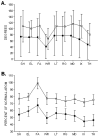Active range of motion predicts upper extremity function 3 months after stroke
- PMID: 19265051
- PMCID: PMC2718540
- DOI: 10.1161/STROKEAHA.108.536763
Active range of motion predicts upper extremity function 3 months after stroke
Abstract
Background and purpose: After stroke, 80% of patients experience acute paresis of the upper extremity and only approximately one-third achieve full functional recovery. Predicting functional recovery for these patients is highly important to provide focused, cost-effective rehabilitation. Our purpose was to examine if early measures of upper extremity active range of motion (AROM) could predict recovery of upper extremity function, and to describe the trajectory of upper extremity AROM recovery over time.
Methods: Thirty-three subjects were tested at 1 month and then at 3 months after stroke. Upper extremity function was measured with 6 standardized clinical tests that were synthesized into a single, sensitive score for upper extremity function using principal component analysis. The ability to move each segment (AROM) was measured using a 3-dimensional electromagnetic tracking system.
Results: Stepwise multiple regression revealed that AROM of the shoulder and middle finger segments taken at 1 month could predict 71% of the variance in upper extremity function at 3 months. All segments of the upper extremity recover similarly and no evidence of a proximal to distal gradient in motor deficits appeared over time.
Conclusions: Simple AROM measurements of the upper extremity taken within 1 month after stroke can be used to predict upper extremity function at 3 months. This information is important for determining the prognosis of upper extremity functional recovery.
Figures

References
-
- Smania N, Paolucci S, Tinazzi M, Borghero A, Manganotti P, Fiaschi A, Moretto G, Bovi P, Gambarin M. Active finger extension: a simple movement predicting recovery of arm function in patients with acute stroke. Stroke. 2007 March;38(3):1088–90. - PubMed
-
- Parker VM, Wade DT, Langton HR. Loss of arm function after stroke: measurement, frequency, and recovery. Int Rehabil Med. 1986;8(2):69–73. - PubMed
-
- Olsen TS. Arm and leg paresis as outcome predictors in stroke rehabilitation. Stroke. 1990 February;21(2):247–51. - PubMed
-
- Konig IR, Ziegler A, Bluhmki E, Hacke W, Bath PM, Sacco RL, Diener HC, Weimar C. Predicting long-term outcome after acute ischemic stroke: a simple index works in patients from controlled clinical trials. Stroke. 2008 June;39(6):1821–6. - PubMed
Publication types
MeSH terms
Grants and funding
LinkOut - more resources
Full Text Sources
Other Literature Sources
Medical

